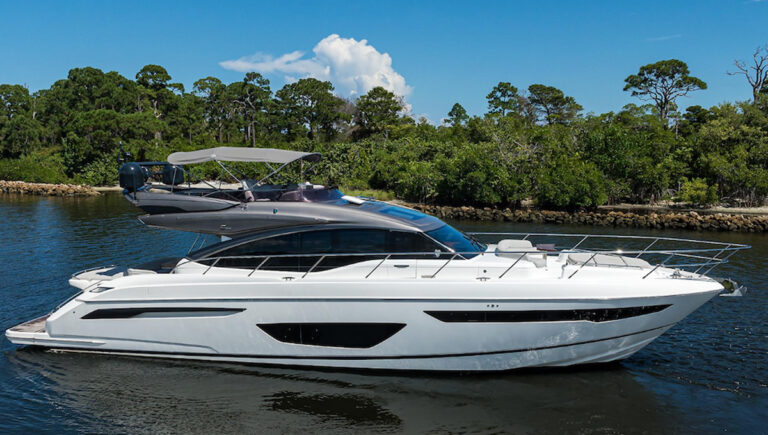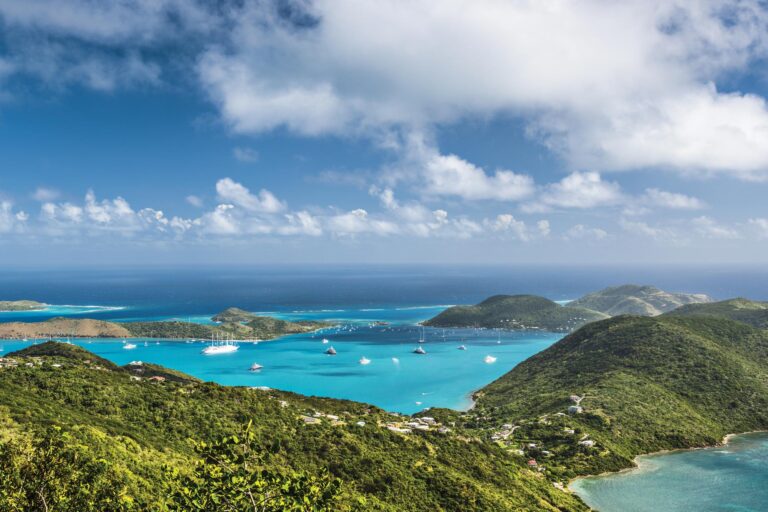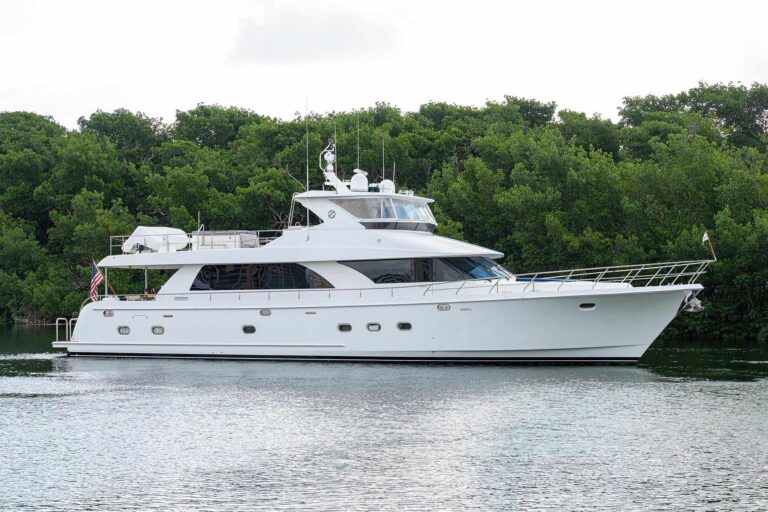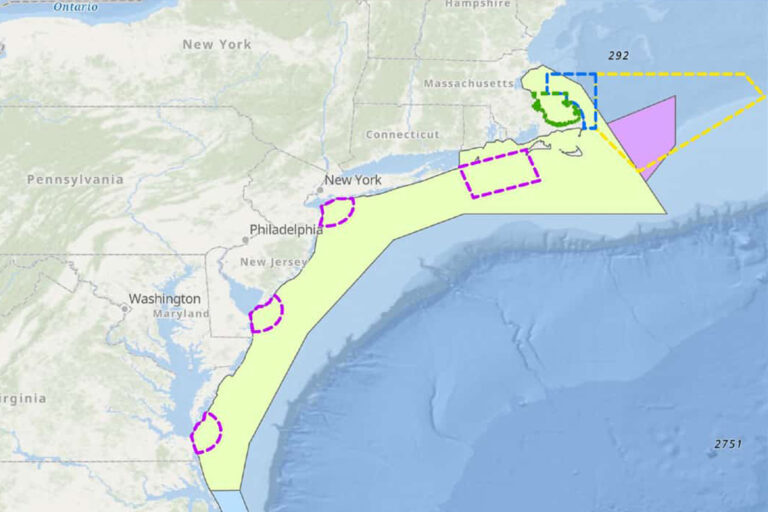I have experienced my fair share of European production boats over the years. The first wave landed on our shores in the early 1980s. A segment of the American yachting population found their styling and performance irresistible, and the boats performed well, but components and systems were foreign. Dealers often had trouble with parts and service.
Much has changed in 20 years, as evidenced by my sea trial of the new Fairline Phantom 50. Several full-service dealers now support the British builder’s products with a state-of-the-art sales and service facility. That’s great peace of mind packaged with a boat that offers a world-class ride.
Our sea trial was in ideal conditions: 15- to 20-knot winds out of the northeast and 4- to 6-foot seas. This is standard fare in Florida during the winter, and such conditions can almost be counted on when planning a trip to the Bahamas. The 50’s hull design, with a transom deadrise of 18 degrees, is similar to the forms common to high-performance American convertibles. She delivered a surprisingly soft, dry ride, and her sound levels were notably low.
To more fully understand the boat, one must understand the builder. Adam Greenwood, technical manager at Fairline, is responsible for developing the builder’s designs and seeing them through production. I have always been impressed with Greenwood and Fairline’s team approach to design and construction, in which designers and craftsmen work together in product-specific groups. Most American yards use production-line techniques.
“By focusing on the production of individual models, our designers and craftspeople develop a more intimate understanding of the product”, Greenwood said. “This, in turn, leads to innovation in new design and to the timely refinement in current models.”
Computer-aided design is helpful, but Fairline builds full-scale mockups for designers and engineers to use. The pre-production process takes about 18 months.
The Phantom 50 includes countless examples of how successful this approach can be. Her helm, like that aboard most modern designs, is well endowed with navigation electronics, yet a hidden pullout chart holder is a pleasing bow to tradition. The galley counter has an area designed to accommodate hot dishes, making it unnecessary to rifle through the drawers for a trivet. Drawers and cabinets are designed to accommodate custom tableware.
While boat designers must always tolerate compromise, the 50’s design has less than most. The optional combination washer/dryer hidden under the passageway steps is a bit out of the way, but it still beats standing in line. The air-conditioned crew cabin in the lazarette is tiny, but I suspect most American customers will pass on this $16,339 option and use the space as a utility room. The $17,343 passerelle is a work of art, yet boarding stern-to is rarely necessary on this side of the pond.
Exterior public areas are a key asset, and the flying bridge is the social centerpiece on this design. Fairline extended the flying bridge well aft, creating an express cruiser-style layout atop the deckhouse. In addition to a full helm station, there is a lounge area with a sink, a refrigerator and a grill. Access is from the afterdeck.
A sliding door framed in stainless steel on the afterdeck opens to a main cabin with a saloon aft and a galley and an interior helm station forward. A comfortable U-shape saloon settee is next to a cocktail table that converts to a dining table. The curved settee to starboard is a bit small to be practical, but it incorporates two ottoman-style seats that can be moved tableside.
Also in this space are a full-service bar with an ice maker, and a built-in television (features becoming more available on European designs because of the American market’s influence). The galley has a three-burner range, a microwave-convection oven and dual-voltage refrigeration.
A passageway on centerline leads forward to the belowdecks accommodations. The master is forward with an island berth and a private head. The two guest staterooms are partially tucked under the main cabin, but the berths are accessible and comfortable. A second head with a shower is accessible from the passageway and the starboard-side stateroom.
The average American will have no reason to find the accommodations cramped-a common objection to European designs.
“Our goal has been to satisfy the expectations of international markets without compromising Fairline’s heritage”, Greenwood said. “I feel that this effort has resulted in a better product.”
This boat’s styling cues have much in common with other European designs, yet she is uniquely British. Her interior is a bit more conservative than you might expect, with dark woods, rich soft goods and high-end hardware. From her owner’s manual to her joinery design, she has a level of detail uncommon in production boats.
The 50 is built at Fairline’s Weldon production plant in the United Kingdom. The hull and superstructure laminates are a combination of handlaid chopped strand mat, stitched multidirectional and woven roving reinforcements together with polyester resin.
While most American builders spray the gelcoat into the mold, Fairline-like a number of European builders-applies gelcoat with a brush. Some suggest brushing results in a better finish, but I would guess the rationale for using the technique has more to do with habit and an interest in reducing airborne emissions. That said, the 50’s exterior detailing and finish are well above average.
A closely spaced network of fiberglass hat-section frames supports the 50’s solid fiberglass hull. The resulting structure is less dependent on interior bulkheads for stiffness and strength, so designers have a bit more latitude with interior arrangements. Liners forward of and abaft the engineroom define the interior layout and are bonded to the hull structure. Superstructure and decks are cored with closed-cell foam, which is hand-applied to the laminate. This relatively stout, conservative construction is an important asset for a boat of this type.
The engineroom is accessible from the afterdeck. It is small by American standards, for cultural reasons. Fairline is careful to provide access to regular maintenance items such as fluids, but the design assumes professionals will handle complicated service. The builder provides machinery removal hatches, prescribes repair methods and establishes a standard for the time (expense) related to various tasks.
Ancillary equipment is separated from the engineroom. The generator is in a machinery space aft, and a machinery space forward accommodates the air conditioning and has stowage for cruising supplies and spare parts. Our test boat had a pair of 675 hp Volvos with electronic controls and power steering. A range of horsepower options is offered, but the Volvos are a good match. Running in a beam sea, we had a top speed of 32.5 knots at 2350 rpm and a cruising speed of 29 knots at 2100 rpm. Fairline’s data suggest a top speed of 34 knots with these engines, which might have been possible in more favorable conditions.
Fairline products shipped to the United States are equipped with 60-cycle electrical service, and most significant components are of American manufacture. The equipment list is complete by American standards and includes everything from electronics to tableware and linens.
Contact: Fairline Boats of North America, (843) 342-3453; fax (843) 342-3483; fbna@hargray.com; www.fairline.com.









